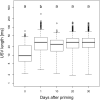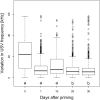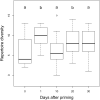Primed to vocalize: Wild-derived male house mice increase vocalization rate and diversity after a previous encounter with a female
- PMID: 33296411
- PMCID: PMC7725367
- DOI: 10.1371/journal.pone.0242959
Primed to vocalize: Wild-derived male house mice increase vocalization rate and diversity after a previous encounter with a female
Abstract
Males in a wide variety of taxa, including insects, birds and mammals, produce vocalizations to attract females. Male house mice emit ultrasonic vocalizations (USVs), especially during courtship and mating, which are surprising complex. It is often suggested that male mice vocalize at higher rates after interacting with a female, but the evidence is mixed depending upon the strain of mice. We conducted a study with wild-derived house mice (Mus musculus musculus) to test whether male courtship vocalizations (i.e., vocalizations emitted in a sexual context) are influenced by a prior direct interaction with a female, and if so, determine how long the effect lasts. We allowed sexually naïve males to directly interact with a female for five minutes (sexual priming), and then we recorded males'vocalizations either 1, 10, 20, or 30 days later when presented with an unfamiliar female (separated by a perforated partition) and female scent. We automatically detected USVs and processed recordings using the Automatic Mouse Ultrasound Detector (A-MUD version 3.2), and we describe our improved version of this tool and tests of its performance. We measured vocalization rate and spectro-temporal features and we manually classified USVs into 15 types to investigate priming effects on vocal repertoire diversity and composition. After sexual priming, males emitted nearly three times as many USVs, they had a larger repertoire diversity, and their vocalizations had different spectro-temporal features (USV length, slope and variability in USV frequency) compared to unprimed controls. Unprimed control males had the most distinctive repertoire composition compared to the primed groups. Most of the effects were found when comparing unprimed to all primed males (treatment models), irrespective of the time since priming. Timepoint models showed that USV length increased 1 day after priming, that repertoire diversity increased 1 and 20 days after priming, and that the variability of USV frequencies was lower 20 and 30 days after priming. Our results show that wild-derived male mice increased the number and diversity of courtship vocalizations if they previously interacted with a female. Thus, the USVs of house mice are not only context-dependent, they depend upon previous social experience and perhaps the contexts of these experiences. The effect of sexual priming on male courtship vocalizations is likely mediated by neuro-endocrine-mechanisms, which may function to advertise males' sexual arousal and facilitate social recognition.
Conflict of interest statement
The authors have declared that no competing interests exist.
Figures











Similar articles
-
Ultrasonic vocalizations in house mice depend upon genetic relatedness of mating partners and correlate with subsequent reproductive success.Front Zool. 2020 Apr 3;17:10. doi: 10.1186/s12983-020-00353-1. eCollection 2020. Front Zool. 2020. PMID: 32265997 Free PMC article.
-
Spectrographic analyses reveal signals of individuality and kinship in the ultrasonic courtship vocalizations of wild house mice.Physiol Behav. 2012 Feb 1;105(3):766-71. doi: 10.1016/j.physbeh.2011.10.011. Epub 2011 Oct 21. Physiol Behav. 2012. PMID: 22037196
-
Male scent but not courtship vocalizations induce estrus in wild female house mice.Physiol Behav. 2023 Feb 1;259:114053. doi: 10.1016/j.physbeh.2022.114053. Epub 2022 Dec 9. Physiol Behav. 2023. PMID: 36502894
-
The contribution of ultrasonic vocalizations to mouse courtship.Curr Opin Neurobiol. 2016 Jun;38:1-5. doi: 10.1016/j.conb.2015.12.009. Epub 2016 Jan 12. Curr Opin Neurobiol. 2016. PMID: 26789140 Review.
-
From Play to Aggression: High-Frequency 50-kHz Ultrasonic Vocalizations as Play and Appeasement Signals in Rats.Curr Top Behav Neurosci. 2017;30:91-108. doi: 10.1007/7854_2015_432. Curr Top Behav Neurosci. 2017. PMID: 26728173 Review.
Cited by
-
Solitude and serotonin: juvenile isolation alters the covariation between social behavior and cFos expression by serotonergic neurons.Front Neurosci. 2024 Oct 22;18:1446866. doi: 10.3389/fnins.2024.1446866. eCollection 2024. Front Neurosci. 2024. PMID: 39502712 Free PMC article.
-
Pre- and post-copulatory traits are affected by experimental inbreeding, but they are not correlated.BMC Biol. 2025 May 28;23(1):144. doi: 10.1186/s12915-025-02245-4. BMC Biol. 2025. PMID: 40437484 Free PMC article.
-
Attraction of female house mice to male ultrasonic courtship vocalizations depends on their social experience and estrous stage.PLoS One. 2023 Oct 10;18(10):e0285642. doi: 10.1371/journal.pone.0285642. eCollection 2023. PLoS One. 2023. PMID: 37816035 Free PMC article.
-
Courtship and distress ultrasonic vocalizations are disrupted in a mouse model of Angelman syndrome.Res Sq [Preprint]. 2025 Feb 11:rs.3.rs-5953744. doi: 10.21203/rs.3.rs-5953744/v1. Res Sq. 2025. PMID: 39989972 Free PMC article. Preprint.
-
Ultrasonic vocalizations in laboratory mice: strain, age, and sex differences.Genes Brain Behav. 2022 Jun;21(5):e12815. doi: 10.1111/gbb.12815. Genes Brain Behav. 2022. PMID: 35689354 Free PMC article.
References
-
- Searcy WA, Andersson M. Sexual selection and the evolution of song. Annu Rev Ecol Syst. 1986;17:507–33. http://www.jstor.org/stable/2097007.
-
- Andersson M. Sexual selection. Princeton: Princeton University Press; 1994. 1994. 599 p.
-
- Gerhardt HC, Huber F. Acoustic Communication in Insects and Anurans Common Problems and Diverse Solutions. Chicago: University of Chicago Press; 2002. 542 p.
-
- Catchpole C, Slater PJB. Bird Song Biological Themes and Variations. 2nd ed Cambridge [England]; New York: Cambridge University Press; 2008. xi, 335 p. p.
Publication types
MeSH terms
Grants and funding
LinkOut - more resources
Full Text Sources

